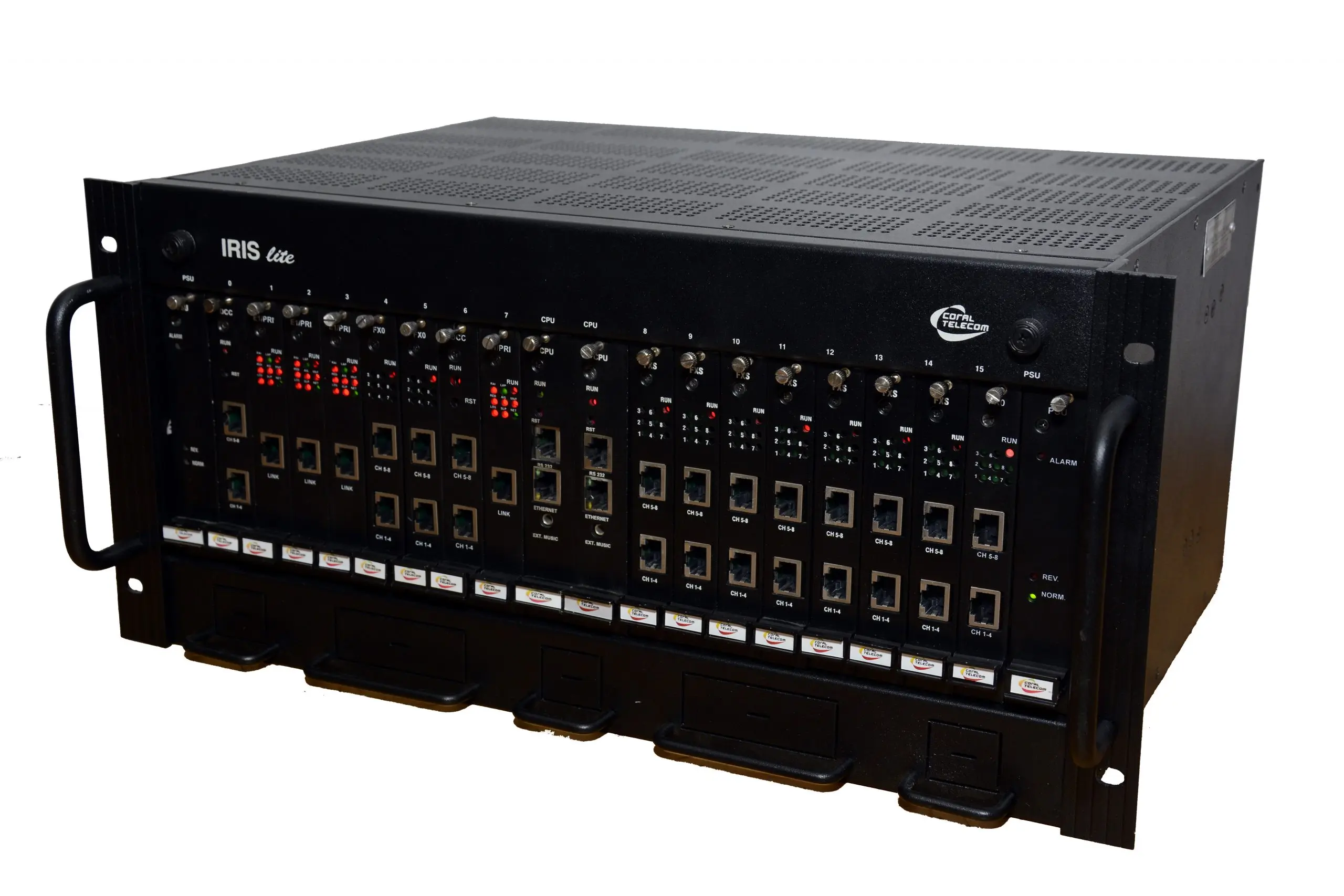Technical Specifications
MCC – Master Control Card-Connection Management
-Feature Management
-Generic Software Installation
-Feature Authorization
-Database Management
-True Hot Standby
Microprocessor – EP9302 (ARM920T Processor)
CPU Clock Rate – 200 MHz
Switching Technology – TDM/PCM
Architecture-100% Fully non blocking
Interface -One 10/100BaseT Ethernet port
GUI/CTI
Local Console-one Rs232 Port
PSU -Power failure Indicator
-Reverse input Polarity Protection
-1+1 Redundancy
-Two Options of input- AC or DC
-Inbuilt Battery Charger with AC-powered
Input DC Voltage
Min Input Voltage-42 VDC
Recom. Input Voltage– 48 VDC
Maxi Input Voltage-54 VDC
Output DC Voltage
Isolated -48 V-Maxi 2 Amp
Over Protc.
Ring Voltage
Ring Frequency-20 Hz
Ring Voltage-70+/-Vrms
Environment
Operation Temp-0 ° C to 60°
Humidity-Up to 95% relative
Storage temperature-0° C to 40°
FXS–
– Front panel LEDs Status for all 8 port of FXS8
-Generate Line Reversal
-Regenerate 16 KHz for PCO Extension
-Supports Caller ID – FSK1/2/3 & DTMF
-Gain Control in both direction (RX & TX)
Number of Analog Ext Ports-8/16/32
Voice encoding-As per ITU-T G.711 &
TechniqueA LAW
Audio Impedance-600/900/complex
Talk Battery-50VDC Nom
D.C. Loop Limit-3300Ω Max (excluding station)
D.C. Loop Voltage-42 VDC to -56 VDC
D.C. Loop Current-20 mA
Ring Battery-75Volt Ac @20 Hz
Dialling Mode-DTMF/ Decadic Pulse
Detecting Pulse Rate-8-22 PPS
Detecting Pulse M/B ratio – 25-75%
DTMF reception level-29 dbm
DTMF reception signal duration-Minimum 40 ms
DTMF reception inter-digit pause-Minimum 40 ms
Message battery-110VDC Nom.
FXO (8 Port Analog Trunk Card)
-Front Panel LEDs to show the operational status of all 8 ports
-Loop status detection and Signaling exchange
-Supports polarity reversal detection
-Supports DTMF/FSK CLI detection
-Programmable Gain control in both TX & RX
Number of port-08
Voice encoding technique-As per ITU-T G.711 and A law encoding
Impedance-2 wire 600Ω
Dial-DTMF / Decedic Pulse
Signalling-Loop Start
On-Hook impedance-Above 1MΩ
E&M – 8 Port Card (Trunk) – Front Panel LEDs to show the operational status
-Loop status detection and Signalling exchange
-Programmable Gain control for RX /TX
-Can be used as 4 wire or 2 wire
Number of ports -08 Port
Termination -Capacitor-coupled transformer, non-grounded
Transmission -2-wire or 4-wire
Impedance -Selectable 600 or 900 Ω nom.
Dialling Mode -DTMF/Decadic Rotary Pulse
M lead– Strappable Form C Contact
M battery -48VDC @ 25mA Max
E lead -Strappable Current Detector
E Sensitivity -5mA Min or 1500 Ω to Ground Max
Networking -With any standard System
ISDN-U Interface Card-Support up to 4 – 5 km on single pair copper wire
-Remote Power Feeding for NT1
-Provide 128 Kbps to support Video Conferencing
Number of ports-8 Port
Line Bit Rate-192Kbps
Voice Channel-2 nos. of 64 kbps on every port
Out put termination-100Ω
Out put pulse-750 mV Zero to Peak over the 100W termination
Input termination-100Ω
Visual Indicators-LED for each port to indicate LINK status
ISDN-S Interface Card -Can work as ISDN Trunk and also as ISDN extension
-Support up 100 meter two pair copper wire
-Remote Power Feeding for NT2
-Provide 128 Kbps to support Video Conferencing
Number of ports-8 Port
Line Bit Rate-192Kbps
Voice Channel-2 nos. of 64 kbps on every port
Out put termination-100Ω
Out put pulse-750 mV Zero to Peak over the 100W termination
Input termination-100Ω
Visual Indicators-LED for each port to indicate LINK status
DCC-Digital Communication Card
Number of ports-8 Ports
Terminals-DKT/DPEM
Feeding Voltage-48 VOLT DC (approx)
Feeding Current-Maximum 70 mA
Transmission Rate-144 Kbps
Circuit Impedance-100Ω nom
Channel Capacity-2B+D
UDGT Card – Universal Digital Trunk Card (E1/T1/PRI)
Number of Voice Channels -30/120
Standard Compliance– ITU-T G.703,G.704
Signalling with E-1 -Decadic/DTMF/ R2MFC
Protocol in PRI -Q931/Q921/Qsig
Line Code -HDB3
Impedance -120Ω/ 75 Ω
Clock Interface Bit rate– 2.048 Mhz
Line Code-AMI
Clock Mode
Master -Transmit clock locally generated, and independent of received data rate.
Slave -Transmit clock locked to receive data
GSM (8 Port GSM Trunk Card) – 4G
Number of ports-4 Nos
Input Voltage-3.3 volt to 4.8 Volt DC
Nominal Impedance-50 Ω
Temperature range-40°C to +90°C
Contact resistance-15m_ max.
Insulation resistance-500M_ min.
Return Loss of Module-RX- ≥8 db, TX – Not Applicable
Recommended Return Loss of
Application-RX – ≥12 db
TX – ≥ 12 db
Transmit Power-Class 4 (2W) at EGSM 900
Class 1 (1W) at GSM 1800
Speech Codec-Half Rate (ETS 06.20)
Brief Specification of Discreet Antenna
TYPE-Car Antenna
Gain-3 DB
Cable-Coax cable 174A (5 m)
Connector-SMA (MALE)
User Interface
- Single Line Telephone(SLT)
- Proprietary Digital Telephone
- Digital Telephone with Graphical Display
- ISDN phone
- Magneto Phone
- Analog Conferencing Equipment
Caller Line Identification
- DTMF (ITU-T)
- FSK CLI with Name Display
- CLI on analogue/Digital CO (P&T) trunks
- CLI CW support
Loop Resistance
Protocols Supported
- DTMF
- Loop Dial
- R2 MFC (Indian Modified)
- R2 MFC (CCITT)
- PLCC signalling
- QSIG
- VOIP(SIP)
Ringer Voltage
Storage Media
- Kernel memory 4 MB EPROM
- Program memory Flash Rom 128MB
- Database storage static Ram 8MB
- System memory SDRAM 256 MB
Interface Networking
- Analog CO Lines
- Analog DID/DOD/BWT (LD)
- Analog E&M (2W/4W)
- Magneto / Ring Down
- Digital ISDN BRI (S&U)
- Digital ISDN PRI (30B+D)
- Digital CEPT/E1
- QSIG on PRI
- PRI/E1 over optical interface
